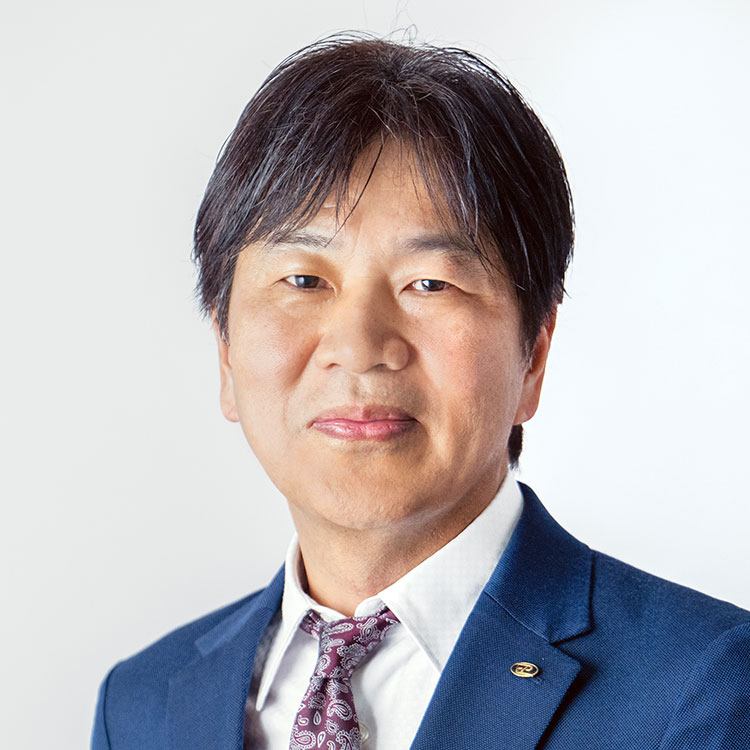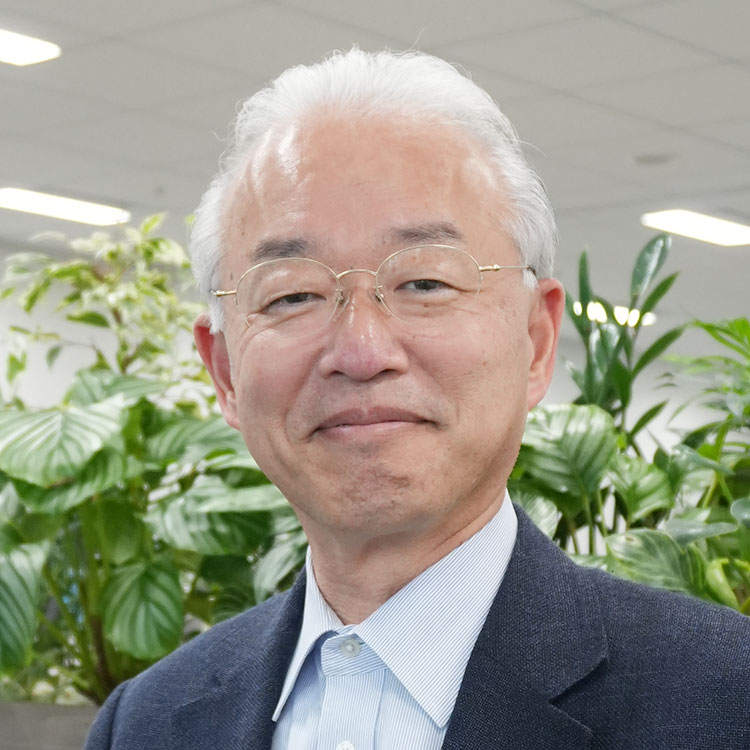In October 2024, PACIFIC CONSULTANTS launched the Advanced Technology Center as an organization specializing in technological development functions. Obtaining intellectual property rights (patents) not only enhances a company's credibility as proof of high technological capabilities, but also contributes significantly to improving corporate value and strengthening its financial base by creating new businesses and securing licensing income. We talked to Shigeto KOUMURA, Director of Advanced Technology Center; Takehiro KIMORI, who is in charge of overall intellectual property strategies in the Technology Strategy Sec. and Kazuto KOMATSUBARA, who is responsible for creating new intellectual property businesses, about the current state of intellectual property strategies and future initiatives.
INDEX
- Establishing Advanced Technology Center in Autumn 2024
- Developing new businesses from the perspective of utilizing intellectual property
- Commercializing equipment maintenance based on point cloud data
- "Nationwide Movement Statistics" and "Doshaburu" were also released
- Utilizing intellectual property to create new businesses and improve corporate value
- "From Defense to Offense" - Pave the future with an intellectual property strategies
Establishing Advanced Technology Center in Autumn 2024
PACIFIC CONSULTANTS is an organization centered around highly skilled engineers, with a total of over 1,300 registered Professional Engineer (PE). We utilize our comprehensive capabilities to contribute to all areas that support social life, such as the construction and maintenance of roads, railways, rivers, ports, airports, disaster prevention measures, urban redevelopment, and environmental conservation, while also continuing to work on solving new social issues such as digital transformation, carbon neutrality, and smart cities.
The driving force behind this has been the development of various technologies and their social implementation. In fact, being supported by a unique corporate culture known for its love of new things and a strong spirit of challenge, the company has produced many innovative technologies. In 1991, the company established the General Research Institute as an organization to ensure technical quality and support research and development. Since then, the company has undergone several name changes, and in October 2024, the Quality Technology Development Department, the department in charge of quality, was spun off and restarted as the Advanced Technology Center, specializing in technological development, where it remains to this day.
Advanced Technology Center is made up of four Dept.: Technology Strategy Sec., Technology Development Sec., Technical Research Institute, and the Option Creation Sec., and is responsible for all of our technological development efforts. While we already hold a number of patents among the top construction consultants, simply possessing technology is meaningless. It only becomes valuable when it is implemented in society in various forms and contributes to solving social issues. In addition to firmly protecting our existing intellectual property, we are also required to proactively patent technologies currently being developed and used at the forefront, and to effectively use these to create new businesses and tackle social issues. Advanced Technology Center's mission is to comprehensively manage the strategic utilization of this intellectual property, including developing the human resources who will be responsible for it.
Developing new businesses from the perspective of utilizing intellectual property
The background of establishing the Advanced Technology Center was the reflection that intellectual property had not been fully utilized in the past. It was KOMATSUBARA who brought this realization to him. KOMATSUBARA had moved from a financial institution and, as a finance expert, was tasked with improving financial literacy across the company by examining the profitability of business investments and fundraising methods. Later, as he took on a new mission of developing new businesses, he once again faced the issue of intellectual property strategy for the company's technology. KOMATSUBARA looks back on this experience.
"In order to explore the possibility of new businesses, we asked a wide range of several departments. As you'd expect from a technology company, we have a lot of groundbreaking ideas. However, fewer of them were secured in the form of patents than we had expected, and there didn't seem to be any recognition of the importance of intellectual property at the site, or any strong desire to obtain patents. What seemed to me to be amazing technology was just one part of the project to the people actually in charge, and once they presented it at an academic conference and received recognition, that was the honor and that was it. Our engineers are focused on developing technology to make their current projects a success, so it may be difficult for them to take a bird's-eye view of the technology of our entire group. There may also have been the typical engineer-specific modesty of thinking, 'It's not good enough to warrant a patent.' But I felt that these technologies should be put to better use in order to grow the company." KOMATSUBARA took the lead and began efforts to obtain patents and create new businesses using those technologies, while the idea of establishment an Advanced Technology Center began to mature.
Commercializing equipment maintenance based on point cloud data
One of our new IP utilization initiatives is a facility management system that utilizes point cloud data. Point cloud data is a representation of an object using countless points, captured using a laser scanner or other device. The collection of tens or even hundreds of millions of points enables the reproduction of extremely precise 3D models. Photographs are 2D data and lack depth information. However, point cloud data contains 3D coordinate data for each point, allowing for the reproduction of a 3D image that can be viewed from any angle. Furthermore, each point can contain a variety of information beyond location, so 3D models not only show shape but also reproduce color, dirt, and scratches. By capturing images of machinery and equipment in factories with robots or drones and using the data as point cloud data, we can understand the condition of the equipment and consider maintenance policies without having to enter the site. Furthermore, our proprietary technology displays attribute information of machinery and equipment (such as manufacturer, specifications, and maintenance history) on a 3D screen as nameplate data, and we have added software innovations that enable even large point cloud data to be handled smoothly. This is a groundbreaking technology for applying 3D point cloud data to maintenance situations.
We worked to obtain a patent for this technology and then commercialized it as a service that can be used for facility maintenance and management. The demonstration received a great response, with many people expressing interest in signing a contract. Sales were conducted using a subscription model, which was not previously used by our company. As long as the product is used, customers will receive a fixed monthly income. Furthermore, as sales will be primarily to private companies, we have secured a new sales agent with an extensive network of private companies, and we will receive license fees based on sales results.
"Nationwide Movement Statistics" and "Doshaburu" were also released
A new business utilizing our intellectual property has been the creation of human flow data service called "Nationwide Movement Statistics." This service combines location information data for tens of millions of devices based on SoftBank's mobile phone base station data with PACIFIC CONSULTANTS' expertise in social infrastructure for urban and transportation planning to provide detailed human flow data. Our patented technology is used in the people flow analysis and traffic prediction programs.
Because it can provide highly accurate data on people's movements and stays, and can also expand estimates to cover the nationwide population of approximately 120 million people, it is widely used in a variety of applications, including formulating transportation policies to alleviate congestion and curb inflows, urban development, disaster prevention planning, marketing, and considering store opening strategies.
In addition, we have jointly developed and commercialized a technology with a private company that incorporates spherical solar cells inside the display surface of signboards, storing electricity generated during the day in a battery and allowing it to glow at night. This technology has also been patented. We also offer "Doshaburu," a landslide risk information service that combines high-precision, short-term radar rainfall data with topographical data, on a professional subscription model.
Utilizing intellectual property to create new businesses and improve corporate value
Obtaining a patent has many benefits. One of them is making our technical capabilities visible. Patents serve as proof of our technical capabilities and increase our credibility with customers. Obtaining a patent also reduces the risk of technology leaks and ensures the protection of our company's technological assets. Furthermore, by using intellectual property as a starting point, we can develop new businesses with new partners, develop new markets, and create platform-based businesses. Of course, business development centered on patents also leads to expansion into international markets. We are currently seeking to obtain international patents in the United States, Thailand, Indonesia, China, and other countries. Intellectual property opens up new possibilities for collaboration with overseas companies and technology exports, providing a foothold for global business expansion.
Another benefit is the diversification of revenue sources. By adding stable, regular revenue from licenses and royalties from technology provision to the traditional project-based revenue, a more stable revenue model can be built, creating a financial structure that is resilient to economic fluctuations and changes in the market environment.
"From Protect to Attack" - Pave the future with an intellectual property strategies
Technologies in the fields of social infrastructure and the environment have a wide range of applications, making it possible to develop a variety of business models based on intellectual property. To achieve this, it is necessary to clearly patent in-house technologies and utilize them as seeds for new businesses. For this reason, the Advanced Technology Center began an initiative in our company's previous fiscal year (FY74th) to provide one-stop support for everything from discovering intellectual property to filing and obtaining rights. We are also working to create an environment in which engineers can work on intellectual property activities with peace of mind, by publishing a "Simple Manual for Obtaining Patents," simplifying internal procedures, and strengthening our patent consultation system.
KOUMURA, Director of Advanced Technology Center, talks about the future promotion of intellectual property strategies:
"Fundamentally, patents are obtained to resolve 'problems in the field,' and we believe that innovations and ideas linked to the technologies that our employees regularly work with have a high chance of being patented. At the same time, in order to uncover intellectual property, it is also important to predict what kind of technologies will be required in the market in the future. Even though it is difficult to make detailed predictions, obtaining patents in technology fields that are in line with megatrends, such as technologies that compensate for labor shortages, technologies that will be useful in maintaining and managing the infrastructure that will clearly increase in the future, and technologies that make use of advances in IT and AI, is extremely important considering the future development of our company's business. Intellectual property is born from the ideas and technologies of each and every employee. I would like all employees to keep in mind, in their daily work, that something could be patented, or that this technology could be used in other fields.
Strengthening our efforts in intellectual property goes beyond simply protecting technology; it is directly linked to the company's growth strategy itself. By shifting our mindset from 'protecting technology' to 'attacking with technology', and by having our engineers and intellectual property managers work together to strengthen the role of intellectual property as a bridge between technology and business, I believe we will be able to balance our technological capabilities with market competitiveness."
Pioneering the future with intellectual property strategies -- Advanced Technology Center is at the forefront.









